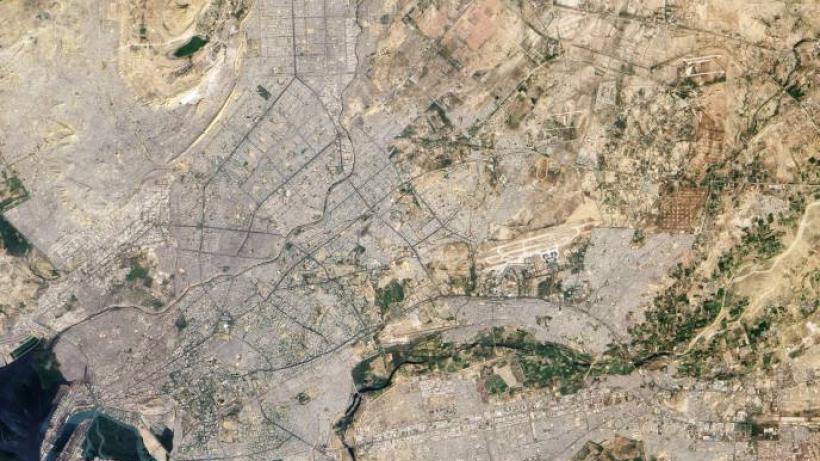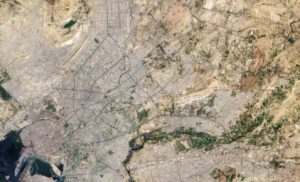
The six biggest challenges facing Pakistan's urban future
Pakistan is among the most urbanized countries of South Asia. As challenges mount, urban planning is gradually finding space in the policy discourse. This is the first of three blog posts on Pakistan’s rapid urbanization. It discusses the pace of urbanization and the major problems associated with it. This will be followed by posts on how the government is responding to the challenges and how and whether the research community is engaged in seeking solutions.
With an urban population growing three percent per year, Pakistanis are flocking to cities faster than any other country in South Asia. By 2030, more than half of Pakistan’s projected 250 million citizens are expected to live in cities.
 Karachi
Karachi
The main drivers of Pakistan’s urban growth are high birth rates and migration from rural areas. Migrants are attracted to cities for better jobs and improved access to basic services.
However, urbanization has inflated Pakistan’s biggest cities so rapidly that they struggle to deliver public services and create productive jobs. Urban poverty is on the rise, with one in eight urban dwellers living below the poverty line.
As a result, Pakistan’s cities contribute much less to the economy compared to other developing countries. Pakistani cities – inhabited by 38 percent of the population – make up around 55 percent of total GDP. India’s urban population is 30 percent, with 58 percent of its GDP coming from cities. In Indonesia, urban population and urban share of GDP are 44 percent and 60 percent[1], respectively.
According to the World Bank, Pakistan’s urbanization is also ‘messy and hidden’: Messy from low-density sprawl and hidden as cities grow beyond administrative boundaries to include ‘ruralopilises’, which are densely populated rural areas and outskirts not officially designated as cities. Ruralopilises today are estimated to make up to 60 percent of urban Pakistan[2]. Such urbanization without an accompanying shift in economic patterns does not bode well.
Without better urban planning to accommodate rapid growth, cities have the potential to become hotbeds of discontent and unrest rather than engines of growth and innovation.
Following are the biggest challenges facing urban policymakers.
1. Poor housing quality and affordability
The State Bank of Pakistan has estimated that across all major cities, urban housing was approximately 4.4 million units short of demand in 2015. If current trends continue, Pakistan’s five largest cities will account for 78 percent of the total housing shortage by 2035. Even if urban population remains stagnant, the growing trend of nuclear families who seek housing separate from larger families will increase pressure on housing supply[3].
When provided, housing is often low quality. Pakistan ranks eighth among the ten countries that collectively hold 60 percent of substandard housing across the world[4]. Karachi, one of the world’s fastest growing megacities with an estimated 17 million people, ranks second lowest in South Asia and sixth lowest in the world on the Economist Intelligence Unit’s 2015 livability index.
2. Water and Sanitation
In most Pakistani cities, water is supplied only four to 16 hours per day and to only 50 percent of the population. According to the Asian Development Bank (ADB), 90 percent of water supply schemes are unsafe for drinking. Shared latrines among households are common in cities and access to solid waste management services remains low. In the most population-dense areas of Karachi, one toilet is shared between twenty people. The World Bank estimates that poor sanitation costs Pakistan around 3.9 percent of GDP; diarrhea-related death and disease among children under five being the largest contributors.
3. Transportation
Karachi is the only megacity in the world without a mass public transport system. Meanwhile, the cost of private transportation is estimated to have increased by over 100 percent since 2000. Those who cannot afford the commute are forced to live in unplanned, inner-city neighborhoods.
Increased private transport on urban roads has caused severe congestion. The government has responded by upgrading many urban roads. However, infrastructure for the most common modes of travel in Pakistan – such as pavements for walking or special lanes for bicycles – either does not exist or has been encroached upon. This is despite the fact that 40 percent of all trips in Lahore are made on foot.
Mobility in urban Pakistan is also harder for women. An ADB study found that almost 85 percent of working-women surveyed in Karachi were harassed in 2015.
4. Health
While overall health and nutrition are better for urban than for rural populations[5], child mortality and malnutrition indicators show that Pakistan’s urban poor have health outcomes only marginally better than the rural poor.
Better health outcomes in urban areas are explained by improved access to private health care in cities. But with the exception of immunization, utilization of basic public health services is very low in urban areas.
Poor health outcomes are also a direct impact of the pollution caused by rapid urbanization. According to the World Health Organization, Karachi is the most polluted city in Pakistan with air twice as polluted as that of Beijing. The level of pollution in Punjab’s major cities is also three to four times higher than that determined safe by the UN.
A lack of clean drinking water remains a major contributor to the high mortality rate of children under five years old. According to Save the Children’s 2015 Annual Report, poor urban children in Pakistan are more likely to die young than rural children.
The challenge of global warming has also intensified in cities. A rise in concrete structures across the urban landscape is increasing temperatures within cities.[6] In 2015, an unanticipated heat wave in Karachi led to almost 1,500 deaths.
5. Education
Although urban areas have higher student enrollment and better learning outcomes, close to 10 percent of all children in Lahore, Karachi and Peshawar remain out of school.
Like healthcare, better education in cities is explained by the private sector. From 2001 to 2014, the share of primary enrollment in urban private schools rose from 25 percent to 40 percent.
Moreover, there seems to be an inverse relationship between public schooling and city size. In small cities, approximately 35 percent of all children aged five to nine are enrolled in government schools. In capital cities, that figure drops to 22 percent.
Continued preference for private schools reflects the low quality of government schools in urban centers. While all private schools have basic facilities (drinkable water and toilets), they are missing in around 12 percent of government schools in Lahore.
The absence of educational and health facilities in smaller cities pushes people towards big cities, where service delivery becomes increasingly strained as the urban population grows.
6. Land Management
Outdated land use regulation and building codes, the absence of a unified land record system and patchy data on land use result in poor urban land management. One consequence is extreme inequality in land use. In Karachi, 36 percent of the population lives in formally planned settlements that consume 77 percent of the city’s residential land, where urban density can be as low as 84 people per hectare. On the other hand, Karachi’s many informal settlements have densities of more than 4,500 per hectare. These hugely varying densities have resulted in unequal access to vital urban services.
Unplanned urban sprawl continues unchecked. Housing schemes built beyond city limits have used up an estimated 60,000 acres of prime agricultural land. Both Karachi and Lahore have seen the development of large real estate schemes by private and military developers particularly along the highways. These ventures are redefining urban limits, further straining service delivery.
This blog originally appeared on Developing Pakistan.
References:
[1] Background paper for World Bank (2014) Pakistan Urban Sector Assessment: Leveraging the Growth Dividend.
[2] Qadeer, Mohammad A. 2000. “Ruralopolis: The Spatial Organization and Residential Land Economy of High-Density Rural Regions in South Asia” Urban Studies 37(9): 1583–1603 and Pakistan’s Runaway Urbanization: What Can Be Done? (2014) Edited by Michael Kugelman.
[3] The National Socio-Economic Registry (NSER), based on the Benazir Income Support Programme’s (BISP) Poverty Score Survey (PSS) conducted in 2010, reveals that around 80 percent of the 27 million households surveyed belong to nuclear families.
[4] Source: United Nations MDG Indicators; McKinsey Global Institute Analysis.
[5] These better outcomes occur because the majority of urban populations are in higher socioeconomic quintiles, whereas the reverse is true for rural populations.
[6] Zahid, M and Rasul, G. Rise in Summer Heat Index over Pakistan, Pakistan Journal of Meteorology Vol. 6, Issue 12

